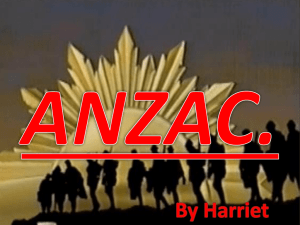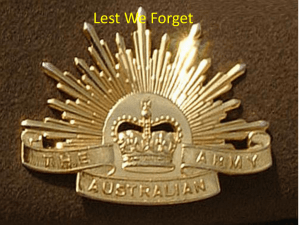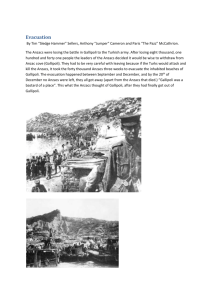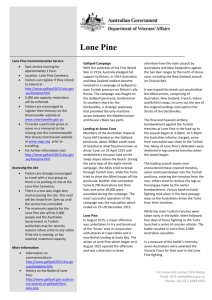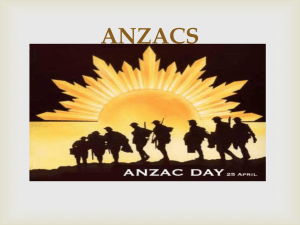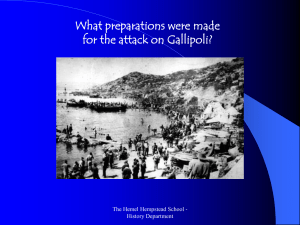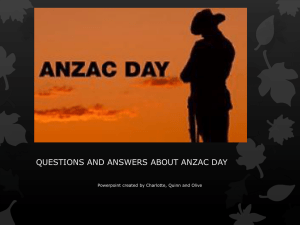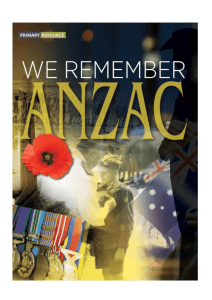Gallipoli Campaign and the ANZAC Legend
advertisement
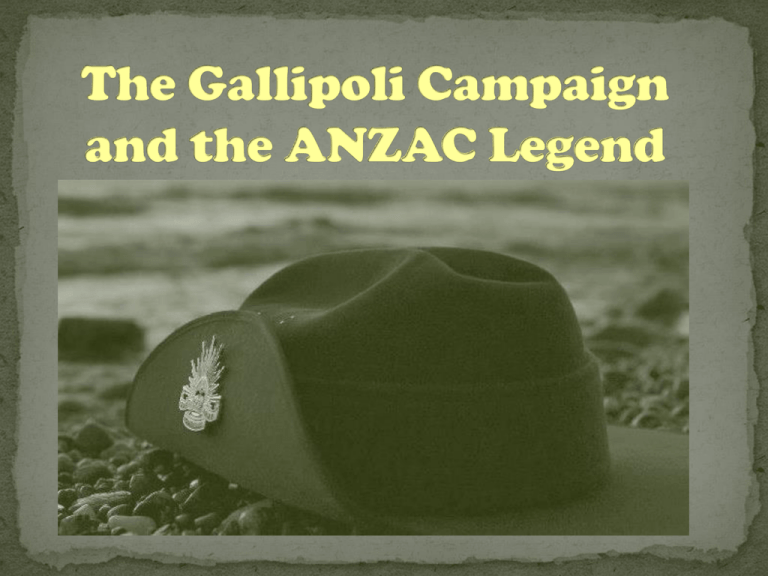
The Gallipoli campaign and the Anzac legend which emerged from it have had a significant impact on ideas about Australia's national identity. Although a military defeat, the bravery and sacrifices associated with the eight-month struggle have had a profound effect on how Australians view this period. For many people, both then and now, the participation of Australian soldiers in the Gallipoli campaign was the symbol of Australia's coming of age as a nation. The experience on the Gallipoli Peninsula formed the framework for a view of the characteristics which identified the 'true Australian'. It also reinforced the 19th century image of the unique attributes of the Australian 'bushman'. Australians could be recognised by their willingness to endure hardship, their bravery and resourcefulness, their spirit of independence and their reluctance to unquestionably accept the authority of others. The ‘Anzac Digger’ There were five particularly 'digger-like' qualities which emerged from the ANZACs when faced with hardship during the Gallipoli Campaign. These included: 1. the ability to remain cheerful, larrikin sense of humour even in the most difficult of times 2. The ability to be resourceful when they had no supplies, for example by making hand grenades from empty tin cans 3. the spirit of mateship in which a soldier would risk his own life for his mate's 4. Australian courage, which was shown on the very first landing at Anzac Cove where the soldiers continued to charge up on to the beach straight into the line of Turkish fire 5. the notion of a ‘fair go’ and that people all deserve the same amount of respect, no matter what their background is. 6. A dislike of authority. It is precisely this type of person and this type of soldier who gave the ANZACs their reputation and instilled a new national pride in Australia The war on the Western Front had reached a stalemate. The war on the Eastern Front was going badly for the Russians What the British hoped to gain: 1.Open sea access in order to send supplies to Russia. 2.Allow British and French battleships to gain control of the 61km long Dardanelles and Constantinople and force Turkey to withdraw from the war. 3.Use infantry (ground troops) to destroy landbased guns protecting the Dardanelles. 4.Gain control of land from which to open a new front against Austria-Hungry. The Gallipoli Landing 25 April 1915 The Gallipoli Campaign began badly because: The failed naval attack in February and March 1915 by British and French battleships had alerted the Turks to the likelihood of a land attack The Turks then had six weeks' advance warning to prepare their defences By the time the Allied troops landed on the beaches of the Gallipoli Peninsula in April 1915, the Turks, under German General Liman von Sanders, had organised reinforcements, strengthened defences, laid mines, constructed trenches and established themselves on the high ground around both sides of the Gallipoli Peninsula and further inland On a number of beaches, troops left their landing craft to face an unrelenting barrage of Turkish machine-gun fire. The Anzacs were landed two kilometres out of position. They faced steep cliffs and machine guns placed along the cliff tops. http://www.abc.net.au/innovation/gallipoli/gallipoli2.htm The Gallipoli Landing 25 April 1915 The Gallipoli Campaign began badly because: The failed British and French naval attack in the Dardanelles in February and March 1915 had alerted the Turks to the likelihood of a land attack The Turks then had six weeks' advance warning to prepare their defences The Turks had organised reinforcements, strengthened defences, laid mines, constructed trenches and established themselves on the high ground The Anzacs were landed two kilometres out of position. They faced steep cliffs and machine guns placed along the cliff tops. Note: The Anzac landing 25 April 1914 was at 4:15 am and they therefore landed in darkness Anzacs Miniseries 1985 Anzac landing 01:00 – 9:40 http://www.youtube.com/watch?v=HIoQ44R-4WE The Landing – 25 April 1915 • By nightfall of the first day, the Anzacs had advanced about 900 metres at a cost of about 2000 casualties, including 621 dead. • Over the next week, another 27 000 soldiers landed at Anzac Cove, where they tried to gain control of the beach and construct trenches — all under constant Turkish fire from as close as 30 metres away. • Soldiers armed with entrenching tools and sandbags had to quickly construct trenches and dugouts to provide some protection. The task was difficult because the men mainly had to lie on their stomachs to dig. Battles of Gallipoli -Lone Pine and The Nek In August, the British decided to try a new tactic to break the stalemate at Gallipoli. Anzac troops were to attack the Turkish strongholds at Lone Pine and The Nek in the hope of distracting attention from Allied troops landing at Suvla Bay and Allied attacks at Sari Bair. The aim was to gain control of Sari Bair and link the Anzac front with Suvla Bay. LONE PINE August 6 – 10 1915 The Anzacs succeeded in taking Lone Pine but at a huge cost to both sides. Over four days of bitter hand-to-hand fighting the Anzacs suffered 2300 casualties and the Turks suffered 6000. Seven Australians gained Victoria Crosses as a result of this action. The Nek - 7 August 1915 The attack at the Nek was even worse. Four waves of effectively suicidal charges by the 3rd Light Horse Brigade went ‘over the top’ to attack the Turkish trenches at ‘Baby 700’, only 27 metres away. The attack failed for a number of reasons: • Allied preliminary artillery shelling ceased 7 minutes too early which allowed the Turks time to return to their trenches and prepare for an assault. • After the 2nd wave of Light Horsemen went over the top, Major Antill believed that some men had reached the Turkish trenches and insisted, despite protests from other commanders, that a third wave should also go over the top. • Colonel Hughes, commander of the 3rd Light Horse, then cancelled the attack. This was too late for the fourth wave, who had already left their trenches. In a forty-five minute period, there were 372 casualties among the Light Horse, of whom 234 died Gallipoli Film 1981 http://www.youtube.com/watch?v=7eeijbtbnjQ EVACUATION – DECEMBER 1915 Allied troops began withdrawing from Anzac Cove and Suvla Bay in early December 1915. They devised a number of tricks to prevent the Turks realising that they were moving out: Australian troops maintained silence for long periods of time and then, when the Turks appeared to find out what was happening, they opened fire. They made dummies and dressed them in uniforms and put them about the cove to give the impression that the area was fully manned. They also organised a method whereby water dripping into a pan attached to a trigger would make a rifle fire itself. By 19 December, the evacuation was complete, with only two casualties. By this time, there were 26 000 casualties among the Anzac troops, including about 10 000 deaths. Today we will : 9 May 2013 • Examine the creation of the Anzac Legend • Determine – Was Simpson a Hero? • The commemoration of Anzac Day • Hand in History and Geography books if I haven’t marked them yet. • Remind your parents to book an interview with me for Parent Teacher night next Monday (if they haven’t done so already) The Creation of Anzac Legend For many people, both then and now, the participation of Australian soldiers in the Gallipoli campaign was the symbol of Australia's coming of age as a nation. British war correspondent Ellis Ashmead-Bartlett (1881–1931) helped create the Anzac Legend with his newspaper report on the Gallipoli landing 8 May 1915. Ashmead-Bartlett's article on the 8th of May 1915 was the first report on the landing of the 25th April that Australian newspapers published. It found an appreciative and ready audience among those who: were concerned about Australian soldiers' reputation for being ‘undisciplined’, gained while they were training in Egypt had been concerned that Australians might have behaved poorly when faced with their first military engagement wanted to see Australian soldiers at least equal the efforts of British and Canadian troops (who had performed well in France) were looking for some sense of a positive national identity for Australia that was distinct from that of Great Britain were concerned about how people of other nationalities would judge Australia in the world arena. Ashmead-Bartlett's articles became the standard for interpreting events and experiences on the Gallipoli Peninsula and identifying the characteristics of the ‘true Australian’. Simpson and his Donkey - A Controversy Private John Simpson Kirkpatrick (1892–1915) was an Englishman who had lived in Australia since 1910 after deserting his position in the merchant navy. Hoping to get back to England, he enlisted in the AIF in August 1914 under the name ‘John Simpson’. He ended up at Anzac Cove. Simpson's actions there were mentioned in official reports and became part of a 1916 book entitled ‘Glorious Deeds of Australasians in the Great War’. The account was propaganda, designed to make readers proud of Australia's war efforts. It greatly exaggerated what Simpson had done and singled him out as a hero at a time when Australia needed new recruits. Simpson served 24 days between his arrival at Anzac Cove on 25 April 1915 and his death. He was meant to serve as a stretcher-bearer transporting seriously wounded men from the front lines back down to Anzac Cove. Instead, he worked by himself, with a donkey, delivering water as he made his way up the heights above the beach, through the dangerous Shrapnel and Monash Gullies and then bringing the wounded back down on his donkey. He and the two wounded he was transporting were shot dead in Monash Gully on 19 May 1915. For many people, Simpson typifies the man of the ‘Anzac Legend’. Others note that he was English, a reluctant recruit, and someone whose help and support of relatively few and not seriously wounded men, while noteworthy, were not really the features that define a ‘hero’. On 25 April 1916 the landing at Gallipoli one year earlier was commemorated. This tradition has continued as Anzac Day on 25th April each year. Red poppies which Australian servicemen later saw in the fields in France on the Western Front in 1916 & 1917 have become the emblem of World War I and Anzac Day.
